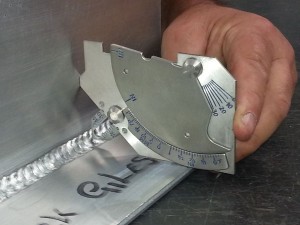Comprehending the Value of Welding Inspection in Ensuring Structural Honesty and Security Across Various Industries
Welding evaluation is a vital procedure that safeguards architectural integrity and safety and security across diverse markets. By carefully analyzing weld quality, assessors help avoid defects that can lead to disastrous failings. This organized assessment not just enhances compliance with sector standards but likewise plays a crucial role in preserving assets and making certain public safety. The effects of disregarding proper evaluation practices are profound, typically resulting in considerable economic and human expenses. As we explore the ins and outs of welding evaluation, the inquiry develops: what are one of the most crucial variables that add to effective examination processes?
Role of Welding Inspection
While the honesty of welded structures is vital to safety and performance, the function of welding assessment can not be overemphasized. Welding inspection works as an important quality assurance process that ensures the adherence to established standards and specifications throughout the welding operation. By methodically evaluating welds for problems, disparities, and non-compliance, assessors play an important function in securing the stability of structures throughout different industries.
Welding evaluations incorporate a variety of tasks, from pre-weld assessments to post-weld assessments. These analyses not only recognize potential issues prior to they escalate however additionally boost the total dependability and lifespan of welded parts. Welding Inspection Milwaukee. Assessments help to verify the skill and expertises of welders, making sure that welding treatments are performed appropriately and products are compatible
Furthermore, an extensive assessment method fosters conformity with regulative demands and industry requirements, reducing the danger of catastrophic failures. By advertising a society of security and liability, welding assessment adds dramatically to both financial and functional effectiveness. In amount, the function of welding evaluation is vital, as it underpins the high quality, safety, and durability of bonded frameworks important to modern-day facilities and industry.
Kinds of Welding Examinations
Comprehending the numerous kinds of welding assessments is essential for preserving the high quality and security of bonded frameworks. Welding evaluations can be classified into a number of kinds, each offering a specific function in the analysis process.
Visual examination is the most essential kind, including a careful assessment of the welds with the nude eye or via magnifying. This technique aids recognize surface area problems such as splits, insufficient blend, or too much spatter.
Following is non-destructive testing (NDT), which consists of strategies such as ultrasonic testing, radiographic testing, and magnetic particle testing. These approaches enable assessors to analyze the integrity of welds without jeopardizing the product's framework. Ultrasonic testing utilizes high-frequency acoustic waves to detect inner imperfections, while radiographic screening uses X-rays or gamma rays to envision interior weld characteristics. Magnetic particle testing, on the other hand, works for discovering surface area and near-surface gaps in ferromagnetic materials.
Devastating screening, though less typical, includes physically examining samples to understand the weld's mechanical buildings. Each sort of evaluation adds to a thorough analysis, guaranteeing that welding fulfills market requirements and safety needs.
Industry Specifications and Regulations
Developing industry criteria and regulations is critical for making sure the security and integrity of welded frameworks. These standards serve as criteria for performance, quality, and safety and security, guiding suppliers and inspectors in the execution of welding processes. Different organizations, such as the American Welding Culture (AWS) and the International Company for Standardization (ISO), have actually developed detailed criteria that determine procedures for welding methods, credentials of welders, and assessment strategies.
Conformity with these policies not just enhances the high quality of welds but also minimizes risks linked with structural failures. Specific codes, such as the ASME Boiler and Pressure Vessel Code, synopsis needs for the construction of pressure vessels, guaranteeing they can withstand operational tensions. Additionally, local and national guidelines often mandate adherence to these sector requirements, enhancing their value across markets like building, aerospace, and automobile manufacturing.
Routine updates to these standards mirror improvements in modern technology and welding strategies, making sure that security actions continue to be pertinent. Therefore, a comprehensive understanding and execution of these standards is essential for welding professionals, cultivating a culture of safety and top quality in bonded frameworks.
Consequences of Poor Inspections
Insufficient inspections can lead to extreme effects in the welding industry, undermining the these details extremely guidelines and requirements designed to ensure safety and architectural integrity. The repercussions of inadequate examinations can manifest in different forms, from immediate security risks to long-lasting architectural failings.
Additionally, insufficient examinations can taint a firm's track record and cause legal consequences, including fines and lawsuits. Non-compliance with well established requirements not only jeopardizes the integrity of jobs but likewise diminishes consumer trust fund in the brand. Additionally, the economic ramifications can be astonishing, encompassing both straight costs connected to repairs and indirect expenses such as shed organization chances and raised insurance policy costs. Eventually, the ramifications of poor inspections prolong beyond specific jobs, affecting industry-wide standards and public understanding, thus stressing the essential demand for extensive and effective welding inspections.
Finest Practices for Effective Evaluations
Efficient welding examinations are vital to making certain the integrity and safety and security of welded structures. To attain optimal results, inspectors need to follow several best methods that improve the evaluation process.

Second of all, examiners should possess the necessary qualifications and certifications pertinent to the welding procedures and materials being taken a look at. Continuous training and specialist development are critical to remaining updated on market criteria and technological innovations.
Additionally, utilizing appropriate inspection devices and strategies, such as aesthetic assessments, ultrasonic screening, and radiographic analyses, is vital for finding problems that could jeopardize structural integrity.
Last but not least, detailed paperwork of the evaluation process is essential. This includes recording findings, photos, and any corrective activities taken. Clear and accurate reporting not just assists in liability yet additionally aids in future evaluations and upkeep. review By executing these best techniques, organizations can considerably boost the effectiveness of their welding examinations and make sure safe, trustworthy operations.
Conclusion

In final thought, welding assessment is important for maintaining structural stability and safety across different industries. Prioritizing reliable welding evaluations is vital to guarantee the security of employees, assets, and general operational integrity.

As we discover the complexities of welding evaluation, the concern arises: what are the most vital aspects that contribute to efficient evaluation procedures?
Welding evaluation offers as a critical high quality control process that guarantees the adherence to established criteria and specifications throughout the welding procedure. In amount, the role of welding evaluation is vital, as it underpins the high quality, security, and durability of welded frameworks important to modern-day facilities and industry.
Different companies, such as the American Welding Culture (AWS) and the redirected here International Organization for Standardization (ISO), have actually created thorough criteria that determine procedures for welding techniques, certification of welders, and examination techniques.
Eventually, the implications of bad examinations expand past specific tasks, influencing industry-wide criteria and public assumption, therefore stressing the critical requirement for efficient and strenuous welding assessments.